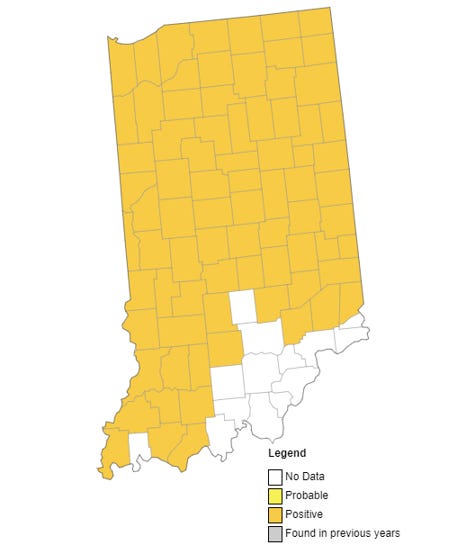
Tar spot is no longer a novelty. It’s can be found alongside gray leaf spot, northern corn leaf blight and southern rust as corn diseases that can cause yield losses in Indiana.
“The northern part of the state is most at risk for yield losses from tar spot, but we’ve now identified it in 78 of 92 counties,” says Darcy Telenko, Purdue University Extension plant pathologist.
During the past two years, Telenko and her team went looking for tar spot, surveying for it in every county in Indiana. The map indicates that it was discovered in all but 14 counties, with new counties confirmed in south-central and southeast Indiana.
 TAR SPOT IN 2020: Counties shaded in yellow indicate tar spot was confirmed in that county in 2020.
TAR SPOT IN 2020: Counties shaded in yellow indicate tar spot was confirmed in that county in 2020.

“The map doesn’t indicate severity of infection, just that we positively identified the disease in fields in those counties,” she emphasizes. “It designates those areas where we should be scouting for tar spot, because it continues moving into new areas. If you live in northern Indiana, it’s an annual problem. Under favorable environmental conditions with high moisture, tar spot can reach severity levels that can cause yield loss.”
Tar spot at a glance
Here’s what you should know about tar spot heading into the 2021 growing season:
History. The disease was first detected in the U.S. in 2015, and the first documented yield losses in Indiana occurred in 2018, Telenko says. It’s caused by the fungus Phyllachora maydis, discovered in Mexico more than 100 years ago.
Habits. The fungus produces ascospores, which can overwinter in residue, Telenko says. When infections start from low in the canopy, it’s often from residue in the field. Telenko says she has even seen this in corn fields in rotation with soybeans.
If weather systems are moving ascospores, first infections may also start in the upper canopy following a spore shower. The fungus prefers cooler temperatures in the 60- to 70-degree F range. However, Telenko believes the most important factor is moisture. At least seven hours of leaf wetness is needed for infection, the pathologist says. “Expect it to show up in irrigated fields or pop-up showers even if it is dry elsewhere,” Telenko says. “We don’t yet know how tillage might impact it.”
Symptoms. In the early stages, it may show up as a single lesion on a leaf appearing as a brown to black raised spot. It can look like insect frass, or Physoderma, another corn disease. “If you rub the leaf and it’s tar spot, it won’t come off,” Telenko says.
What’s most concerning about tar spot is it can go from a few lesions to full-out blight in a matter of a few weeks. “You must scout and keep scouting,” she says, “We often don’t detect it until late in the season, but if it comes in early or under conducive environmental conditions, it has the potential to affect yields.”
Fungicides and timing. Telenko’s work shows a healthy response to a wide variety of fungicides over the past two seasons. There was a higher average yield response in 2020 vs. 2019, even though it came in later in 2020. “Choose fungicides with multiple modes of action,” she says. “Several products are very effective, and we’re continuing to evaluate them.”
Applications at VT to R2 growth stages are typically most effective, she says. It’s a balancing act but going too early may not provide control if tar spot comes in later and applying beyond R3 or R4 may be too late to control the disease and prevent yield loss, Telenko says.
Recommendations for 2021. Especially if you know you’ve seen it in a field going to corn this year, work with your seedsman to find a hybrid that is less susceptible. “No hybrids are fully resistant, but some are more susceptible than others,” Telenko says. “Then watch weather conditions and be on the lookout especially if July and August are wet.”
Be ready to spray if necessary and aim for the VT to R2 timing. “And don’t forget about gray leaf spot, northern corn leaf blight and southern rust,” she cautions. “These are still important foliar corn diseases that appear regularly in Indiana.”
About the Author(s)
You May Also Like




